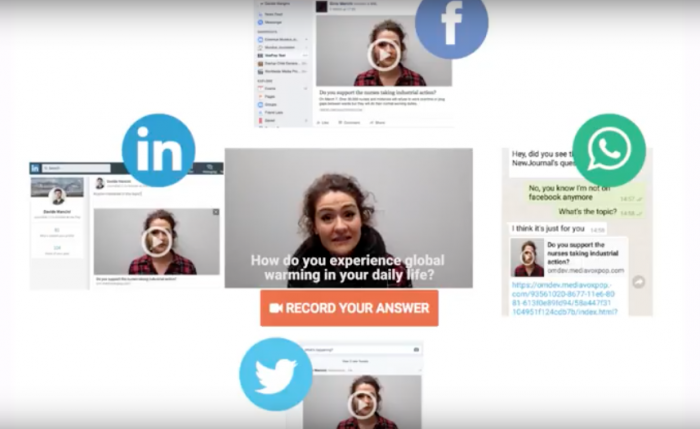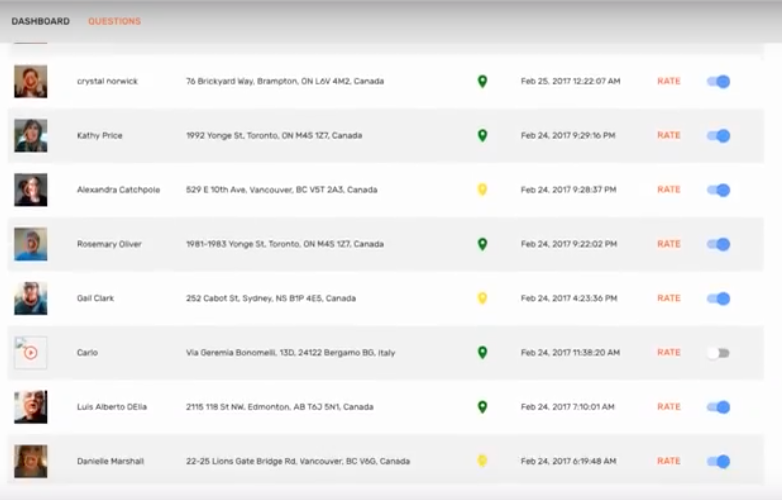
Three years ago, Davide Mancini was trying to make it work as a freelance journalist, after studying war and conflict reporting in graduate school.
“Many times, I found myself wanting to ask the same question to a large number of people, all at the same time — for example, during political demonstrations or catastrophes,” he said. “So I started wondering how I could multiply a question to get a greater number of answers.”
Mancini, with economist Fabio Capoferri and developer Sirio Marchi, is a cofounder of Media Vox Pop (from the broadcasting term), a Google Digital News Initiative-funded Italian media startup that wants to give newsrooms who don’t have broadcast-level experience or resources a simpler way to collect and present video feedback from readers.
“In many cases, newsrooms do not have a clear strategy on how to engage their audience using user generated content,” Mancini said. “It’s still a new kind of content for editors, and it takes a long time to find, license and use.”
For a monthly fee (starting at €100 for outlets with fewer than 250,000 monthly unique visitors), newsrooms get unlimited use of the Media Vox Pop service, which allows them to pose questions in a video format, push the call out to social channels, and organize and publish video responses from the audience. (The fee includes video storage and streaming.)
Questions can range from opinions on political issues to calls for story ideas or advocacy campaigns. Users can record their own answers from any browser and send it back to the newsroom. Newsrooms can then reorder and curate audience responses directly on a dashboard.

In Italy, similar companies like VTTP.co already exist that help media organizations incorporate mobile-friendly video into their websites or apps, though VTTP.co is more focused on marketing and branding, Mancini argues. (The audience engagement component of Media Vox Pop also recalls the U.S.-based Hearken, whose tools allow audiences to participate in newsroom reporting processes from the ideas stage.)
“We have not steered away from placing our emphasis on the journalistic video-question,” Mancini said. “As a young startup, we are still collecting case studies so that we can have concrete numbers to work on.”
One outlet that’s tested out Media Vox Pop is Long Island’s Newsday. Earlier this year, users were asked to offer advice to President Trump as part of Newsday’s first-100-days coverage (the campaign was paired with another interactive where users could give Trump a progress report). In the coming months, an Italian-language digital news site will start a trial, as will a German public broadcaster, according to Mancini.
Newsday had been looking for a way to let its audience submit video responses directly for some time, according to Samuel Guzik, multimedia editor for Newsday’s editorial board. It once tried out soliciting video letters to the editor about red-light cameras on Long Island (a hot topic at the time), but “it was a cumbersome experience that involved some long phone calls between our producers and the readers who wanted to film themselves,” Guzik said. “Media Vox Pop reduces a lot of the friction to collecting that kind of content.”
Audience participation was disappointing on the Trump-related experiment, Guzik said, but that could have been in part because fewer readers were willing to put their faces to opinions on Trump. He’s interested in experimenting again on a different topic: “Our goal is to use a local issue that might animate our readership.”
Other Media Vox Pop testers include institutions like the European Institute for Science, Media and Democracy, which this past summer promoted its REIsearch initiative to connect scientists and with the wider public. Amnesty International has used Media Vox Pop in video campaigns, using it to collect reactions from followers that it then edited into a video for Facebook. The video performed better than the average Amnesty International video, Mancini said, and “the staff expressed satisfaction with the stats as their effort…was much lower than that required for their other videos.”
While Media Vox Pop is slowly growing its client base, as with most startups, its financial stability is still an open question. Mancini is transparent about its situation. “We are generating low revenue, coming mostly from services we offer together with the platform,” he said. Since early 2015, it’s made €133,000 that’s gone largely towards developing the tech; the startup is “getting close to the ‘cliff,'” he said, and will need to reach profitability by October or November.
What lies ahead for a product that organizations appear to enjoy using but might be hesitant to pay for?
“Most of them have not appeared willing to pay for a product that will also require some extra curation within their newsrooms — watching and selecting incoming video content. It’s not easy to introduce a tool that requires some extra effort on the client side, when they are at the same time being charged for the service,” Mancini said. “Such a shift of mentality is not easy. That’s why we have recently started looking into new ways of encouraging newsrooms to adopt our system.”
For instance, it’s been testing taking on that editorial task — curating the video responses that come in after a newsroom posts a question. It’s also considering opening up to more free trials to collect more feedback. Down the line, Media Vox Pop might offer features like embeddable interactive maps that allow audiences to explore how responses varied by geographical location. It’s also looking at ways to develop the service to allow for more fluid debate, rather than just a single call-and-response interaction.
“At the moment, we are still at the first level: getting people to answer,” Mancini said. “We want to help newsrooms pull content in, which is exactly the opposite of what newsrooms have been doing: pushing content out.”